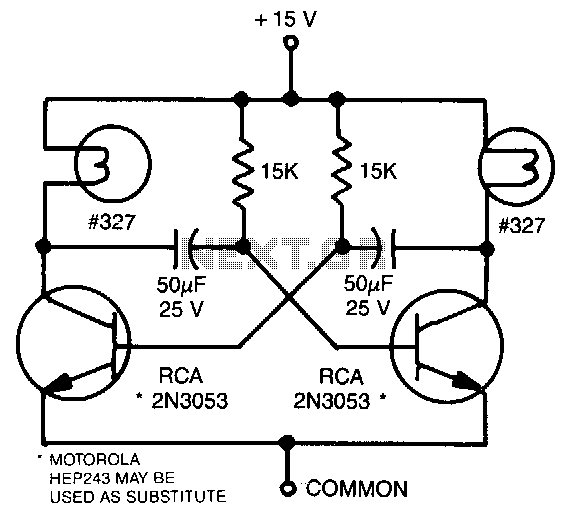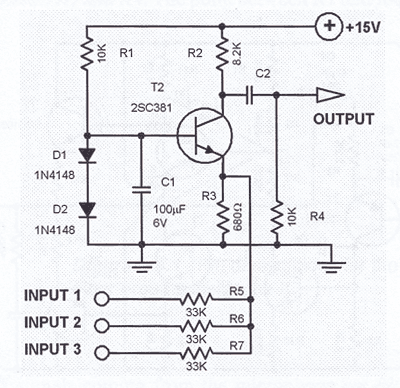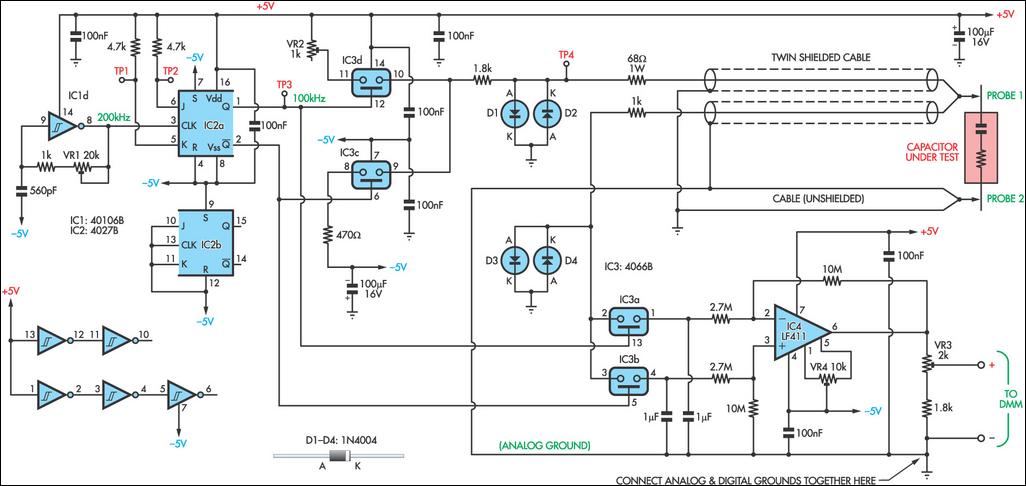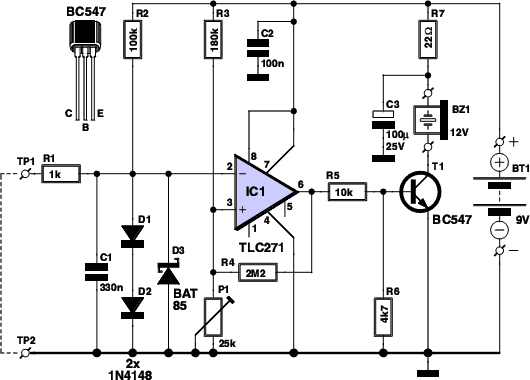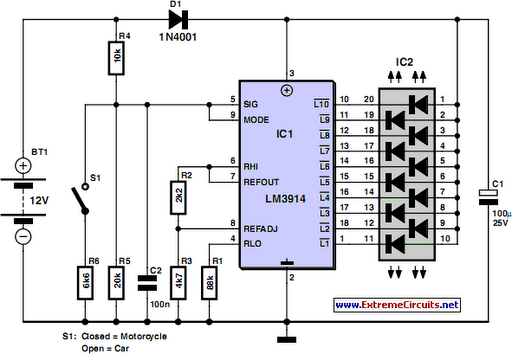
Transistor Tester to test Hfe and working of NPN and PNP Transistors
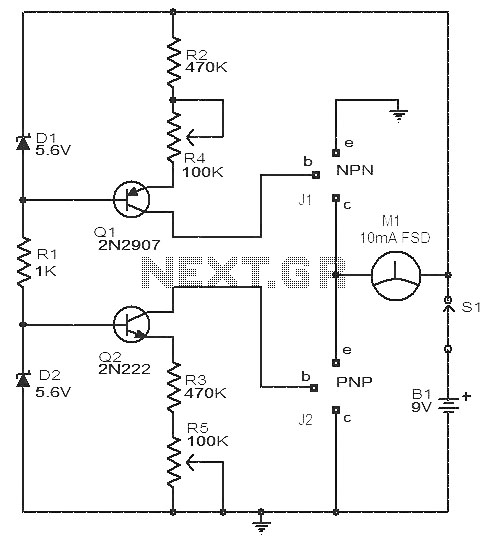
This circuit is a simple device for testing the hfe (current gain) of both PNP and NPN transistors, with the capability to measure hfe values as high as 1000. It operates using two constant current sources formed by transistors Q1 (a PNP transistor) and Q2 (an NPN transistor). The constant current through Q1 is determined by the equation (VD1 - 0.6) / (R2 + R4), where the potentiometer R4 can be adjusted to achieve a constant current of 10 µA. Similarly, the constant current through Q2 is given by (VD2 - 0.6) / (R3 + R5), with R5 also adjustable for a 10 µA output. The current generated by Q1 is fed to the base of the NPN transistor under test, while the current from Q2 is directed to the base of the PNP transistor under test. The meter connected to the circuit is calibrated to directly display the hfe of the tested transistor. This simple transistor tester is suitable for both NPN and PNP transistors, making it a valuable tool for technicians and students. The circuit can be easily assembled on a general-purpose PCB using basic electronic components such as resistors, LEDs, diodes, and transformers. It allows users to check the operational condition of a transistor, determining if it is functioning correctly, open, or shorted. The circuit operates based on basic transistor theory, utilizing the switching action of transistors. During the first half of the AC input cycle, the emitter-base junction of the transistor is forward biased, allowing current to flow through diode D1, which in turn causes the red LED to illuminate. In the second half cycle, the transistor becomes reverse biased and turns off, with the red LED remaining lit if the transistor is functioning properly. The PNP transistor can be tested similarly, with the green LED indicating proper operation. If the transistor is open, no current flows, and if it is shorted, both LEDs will light simultaneously.
The circuit utilizes a straightforward design to test the hfe of both NPN and PNP transistors effectively. The two constant current sources, Q1 and Q2, are critical components that ensure accurate current flow into the transistors under test. The adjustment of the potentiometers R4 and R5 allows for fine-tuning the constant current to a precise value of 10 µA, which is crucial for reliable hfe measurement.
The operation of the circuit hinges on the principle of transistor switching. During the positive half-cycle of the AC input, Q1 is activated, allowing current to flow through diode D1, lighting the red LED. This visual indication confirms that the NPN transistor is operational. Conversely, during the negative half-cycle, Q2 is activated for the PNP transistor, lighting the green LED when the transistor is functioning correctly.
The inclusion of variable resistors enables the user to test transistors at various base currents, providing flexibility in testing conditions. The circuit's design allows it to identify faulty transistors by observing LED behavior: an open transistor will not conduct, resulting in no LED illumination, while a shorted transistor will cause both LEDs to glow, indicating a closed path.
Overall, this circuit serves as an efficient and effective tool for evaluating the operational status of transistors, making it suitable for educational purposes and practical applications in electronics repair and testing.Here is a very simple circuit that can be used to check the hfe of transistors. Both PNP and NPN transistors can be checked using this circuit. Hfe as high as 1000 can be measured by using this circuit. The circuit is based on two constant current sources build around transistors Q1 and Q2. The Q1 is a PNP transistor and the constant current flows i n the emitter lead. The value of constant current can be given by the equation; (V D1 -0. 6)/ (R2+R4). The POT R4 can be adjusted to get a constant current of 10uA. The Q2 is an NPN transistor and the constant current flows into the collector lead. The value of this constant current can be given by the equation; (VD2-0. 6)/(R3+R5). The POT R5 can be adjusted to get a constant current of 10uA. This constant current provided by the Q1 circuit if the transistor under test is an NPN transistor and by Q2 circuit if the transistor under test is a PNP transistor is fed to the base of transistor under test. This current multiplied by the hfe flows in the collector of the transistor and it will be indicated by the meter.
The meter can be directly calibrated to read the hfe of the transistor. Simple transistor tester is a transistor analyzer circuit which is suitable for testing both NPN and PNP transistors. This is a very simple circuit as compared to other transistor testers. This circuit is very useful for both technicians and students. This circuit can be easily assembled on a general purpose PCB. A basic electronic component like resistors, LED`s, diode and transformer is used for developing this circuit.
Using this circuit, we can check whether a transistor is in good condition or not, is it opened or shorted, and so on. The principle behind this circuit is very simple. This circuit basically works on the basis of transistor switching action (Basic Transistor Theory). Take a look at the circuit diagram given below. During the first half cycle of the transformer input, the emitter base junction of transistor is forward biased and collector base junction is reverse biased and the transistor is in ON state and diode D1 is in forward biased The current starts flow through the D1 and the red LED begins to glow.
During the next half cycle, the transistor is reverse biased and is in OFF state. By the alternative nature of the input AC, we can see that the red LED is in ON state and the transistor is in good working condition(Diode D2 and Green Led is in reverse biased and in OFF state). By using the variable resistor, we can check the transistor with various base currents. If the NPN transistor is in open state, the transistor does not conduct and no current flow through LED.
If the transistor is in shorted condition, the transistor acts as a closed switch. And both diode conduct alternatively and both LED`s starts glowing. The PNP transistor is attached to the device with corresponding pin terminals and switch on the circuit. If, during one half cycle of the input AC (assume top terminal of transformer is negative and bottom is positive), the emitter base and collector base junctions of the transistor are forward biased.
Then, in such a condition if there is a and a current flow through the Diode D2 and the Green LED starts glowing, then understand that the transistor is in good working condition(the Diode D1 and Red LED is in reverse biased and not working at that time). During the next half cycle both diodes, and transistors are reverse biased and in OFF state. By the alternating property of input AC, we feel the Green LED is in ON state. We can check this circuit by providing various base currents (by very the variable resistor. If the PNP transistor is in open state, it doesn`t conduct in both half cycles and no output is obtained.
If the transistor is in a shorted condition, transistor acts as a closed path and both diodes are forward biased alternatively, thus making the two LED`s glow at the same time. 🔗 External reference
The circuit utilizes a straightforward design to test the hfe of both NPN and PNP transistors effectively. The two constant current sources, Q1 and Q2, are critical components that ensure accurate current flow into the transistors under test. The adjustment of the potentiometers R4 and R5 allows for fine-tuning the constant current to a precise value of 10 µA, which is crucial for reliable hfe measurement.
The operation of the circuit hinges on the principle of transistor switching. During the positive half-cycle of the AC input, Q1 is activated, allowing current to flow through diode D1, lighting the red LED. This visual indication confirms that the NPN transistor is operational. Conversely, during the negative half-cycle, Q2 is activated for the PNP transistor, lighting the green LED when the transistor is functioning correctly.
The inclusion of variable resistors enables the user to test transistors at various base currents, providing flexibility in testing conditions. The circuit's design allows it to identify faulty transistors by observing LED behavior: an open transistor will not conduct, resulting in no LED illumination, while a shorted transistor will cause both LEDs to glow, indicating a closed path.
Overall, this circuit serves as an efficient and effective tool for evaluating the operational status of transistors, making it suitable for educational purposes and practical applications in electronics repair and testing.Here is a very simple circuit that can be used to check the hfe of transistors. Both PNP and NPN transistors can be checked using this circuit. Hfe as high as 1000 can be measured by using this circuit. The circuit is based on two constant current sources build around transistors Q1 and Q2. The Q1 is a PNP transistor and the constant current flows i n the emitter lead. The value of constant current can be given by the equation; (V D1 -0. 6)/ (R2+R4). The POT R4 can be adjusted to get a constant current of 10uA. The Q2 is an NPN transistor and the constant current flows into the collector lead. The value of this constant current can be given by the equation; (VD2-0. 6)/(R3+R5). The POT R5 can be adjusted to get a constant current of 10uA. This constant current provided by the Q1 circuit if the transistor under test is an NPN transistor and by Q2 circuit if the transistor under test is a PNP transistor is fed to the base of transistor under test. This current multiplied by the hfe flows in the collector of the transistor and it will be indicated by the meter.
The meter can be directly calibrated to read the hfe of the transistor. Simple transistor tester is a transistor analyzer circuit which is suitable for testing both NPN and PNP transistors. This is a very simple circuit as compared to other transistor testers. This circuit is very useful for both technicians and students. This circuit can be easily assembled on a general purpose PCB. A basic electronic component like resistors, LED`s, diode and transformer is used for developing this circuit.
Using this circuit, we can check whether a transistor is in good condition or not, is it opened or shorted, and so on. The principle behind this circuit is very simple. This circuit basically works on the basis of transistor switching action (Basic Transistor Theory). Take a look at the circuit diagram given below. During the first half cycle of the transformer input, the emitter base junction of transistor is forward biased and collector base junction is reverse biased and the transistor is in ON state and diode D1 is in forward biased The current starts flow through the D1 and the red LED begins to glow.
During the next half cycle, the transistor is reverse biased and is in OFF state. By the alternative nature of the input AC, we can see that the red LED is in ON state and the transistor is in good working condition(Diode D2 and Green Led is in reverse biased and in OFF state). By using the variable resistor, we can check the transistor with various base currents. If the NPN transistor is in open state, the transistor does not conduct and no current flow through LED.
If the transistor is in shorted condition, the transistor acts as a closed switch. And both diode conduct alternatively and both LED`s starts glowing. The PNP transistor is attached to the device with corresponding pin terminals and switch on the circuit. If, during one half cycle of the input AC (assume top terminal of transformer is negative and bottom is positive), the emitter base and collector base junctions of the transistor are forward biased.
Then, in such a condition if there is a and a current flow through the Diode D2 and the Green LED starts glowing, then understand that the transistor is in good working condition(the Diode D1 and Red LED is in reverse biased and not working at that time). During the next half cycle both diodes, and transistors are reverse biased and in OFF state. By the alternating property of input AC, we feel the Green LED is in ON state. We can check this circuit by providing various base currents (by very the variable resistor. If the PNP transistor is in open state, it doesn`t conduct in both half cycles and no output is obtained.
If the transistor is in a shorted condition, transistor acts as a closed path and both diodes are forward biased alternatively, thus making the two LED`s glow at the same time. 🔗 External reference
